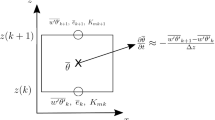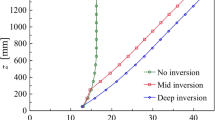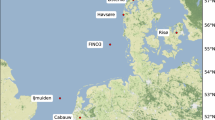Abstract
Low or weak wind-speed conditions, roughly defined as the periods when the mean wind speed at 10 m above the ground is 2 ms−1 or less, are of considerable practical interest. However, they are not readily amenable to treatment within prognostic meteorological models and, consequently, difficult to predict, especially when the ambient stability is strong. In this paper, we apply an E − ε prognostic meteorological model to simulate near-surface meteorology and, focusing on low wind speeds, compare the predictions with measurements from two independent datasets. A sensitivity analysis is performed to investigate the possible reasons for the relatively inferior model performance for low winds when the atmosphere is stably stratified. A comprehensive data analysis is carried out to study low wind stable conditions, concentrating on the validity of various forms of flux–gradient relationships for momentum and heat within the framework of the Monin-Obukhov similarity theory, which models employ for calculating surface fluxes. The observed behaviour of various stability parameters, such as the Richardson number, is investigated. The results point to inadequacies of the current flux–gradient relationships, especially regarding momentum, under strongly stable conditions as being a dominant reason for the poor low wind predictions. The modelling issues identified are not just restricted to the present model, but are general in nature. The use of an alternative stability function for momentum under strongly stable conditions is explored. It results in improved model performance for low winds; however, further research is needed to better understand strongly stable flows in the lower atmosphere and to develop methods that can translate that understanding to operational meteorological modelling.
Similar content being viewed by others
References
Baas P, Steeneveld GJ, van de Wiel BJH, Holtslag AAM (2006) Exploring self-correlation in flux–gradient relationships for stably stratified conditions. J Atmos Sci 63: 3045–3054. doi:10.1175/JAS3778.1
Beljaars ACM, Holtslag AAM (1991) Flux parameterization over land surfaces for atmospheric models. J Appl Meteorol 30: 327–341 doi:10.1175/1520-0450(1991)030<0327:FPOLSF>2.0.CO;2
Brutsaert W (1982) Evaporation into the atmosphere. Kluwer Academic Publishers, Dordrecht, p 299
Businger JA, Wyngaard JC, Izumi Y, Bradley EF (1971) Flux-profile relationships in the atmospheric surface layer. J Atmos Sci 28: 181–189 doi:10.1175/1520-0469(1971)028<0181:FPRITA>2.0.CO;2
Carson DJ, Richards PJR (1978) Modelling surface turbulent fluxes in stable conditions. Boundary-Layer Meteorol 14: 67–81. doi:10.1007/BF00123990
Cheng Y, Brutsaert W (2005) Flux-profile relationships for wind speed and temperature in the stable atmospheric boundary layer. Boundary-Layer Meteorol 114: 519–538. doi:10.1007/s10546-004-1425-4
Cheng Y, Parlange MB, Brutsaert W (2005) Pathology of Monin-Obukhov similarity in the stable boundary layer. J Geophys Res 110: D06101. doi:10.1029/2004JD004923
Cuxart J, Holtslag AAM, Beare RJ, Bazile E, Beljaars A, Cheng A, Conangla L, Ek M, Freedman F, Hamdi R, Kerstein A, Kitagawa H, Lenderink G, Lewellen D, Mailhot J, Mauritsen T, Perov V, Schayes G, Steeneveld G-J, Svensson G, Taylor P, Weng W, Wunsch S, Xu K-M (2006) Single-column model intercomparison for a stably stratified atmospheric boundary layer. Boundary-Layer Meteorol 118: 273–303. doi:10.1007/s10546-005-3780-1
Duynkerke PG (1988) Application of the E − ε turbulence closure model to the neutral and stable atmospheric boundary layer. J Atmos Sci 45: 865–880 doi:10.1175/1520-0469(1988)045<0865:AOTTCM>2.0.CO;2
Dyer AJ (1974) A review of flux-profile relationships. Boundary-Layer Meteorol 7: 363–372. doi:10.1007/BF00240838
Galperin B, Sukoriansky S, Anderson PS (2007) On the critical Richardson number in stably stratified turbulence. Atmos Sci Lett 8: 65–69. doi:10.1002/asl.153
Garratt JR (1992) The atmospheric boundary layer. Cambridge University Press, Cambridge, p 316
Grachev AA, Fairall CW, Persson POG, Andreas EL, Guest PS (2005) Stable boundary-layer scaling regimes: The SHEBA data. Boundary-Layer Meteorol 116: 201–235. doi:10.1007/s10546-004-2729-0
Grell GA, Dudhia J, Stauffer DR (1995) A description of the fifth-generation Penn State/NCAR Mesoscale Model (MM5). Report NCAR/TN-398+STR, 117 pp
Hicks BB (1976) Wind profile relationships from the Wangara experiments. Q J R Meteorol Soc 102: 535–551
Högström U (1996) Review of some basic characteristics of the atmospheric surface layer. Boundary-Layer Meteorol 78: 215–246. doi:10.1007/BF00120937
Holtslag AAM, Nieuwstadt FTM (1986) Scaling the atmospheric boundary layer. Boundary-Layer Meteorol 36: 201–209. doi:10.1007/BF00117468
Hurley PJ (2005) The Air Pollution Model (TAPM) Version 3. Part 1: technical description. CSIRO Atmospheric Research Technical Paper 71. 54 p. Available http://www.cmar.csiro.au/e-print/open/hurley_2005b.pdf
Hurley PJ, Physick WL, Luhar AK (2005) TAPM: a practical approach to prognostic meteorological and air pollution modelling. Environ Model Softw 20: 737–752. doi:10.1016/j.envsoft.2004.04.006
Klipp CL, Mahrt L (2004) Flux-gradient relationship, self-correlation and intermittency in the stable boundary layer. Q J R Meteorol Soc 130: 2087–2103. doi:10.1256/qj.03.161
Louis JF (1979) A parametric model of vertical eddy fluxes in the atmosphere. Boundary-Layer Meteorol 17: 187–202. doi:10.1007/BF00117978
Mahrt L (1998) Stratified atmospheric boundary layers and breakdown of models. Theor Comput Fluid Dyn 11: 263–279. doi:10.1007/s001620050093
Mahrt L, Sun J, Blumen W, Delany T, Oncley S (1998) Nocturnal boundary-layer regimes. Boundary-Layer Meteorol 88: 255–278. doi:10.1023/A:1001171313493
Nieuwstadt FTM (1984) The turbulent structure of the stable nocturnal boundary layer. J Atmos Sci 41:2202–2216. doi:10.1175/1520-0469(1984)041<2202:TTSOTS>2.0.CO;2
Oncley SP, Friehe CA, Larue JC, Businger JA, Itsweire EC, Chang SS (1996) Surface-layer fluxes, profiles, and turbulence measurements over uniform terrain under near neutral conditions. J Atmos Sci 53: 1029–1044 doi:10.1175/1520-0469(1996)053<1029:SLFPAT>2.0.CO;2
Pahlow M, Parlange MB, Porté-Agel F (2001) Monin-Obukhov similarity in the stable atmospheric boundary layer. Boundary-Layer Meteorol 99: 225–248. doi:10.1023/A:1018909000098
Poulos GS, Blumen W, Fritts DC, Lundquist JK, Sun J, Burns SP, Nappo C, Banta R, Newsome R, Cuxart J, Terradellas E, Balsley B, Jensen M (2002) CASES-99: A comprehensive investigation of the stable nocturnal boundary layer. Bull Am Meteorol Soc 83: 555–581 doi:10.1175/1520-0477(2002)083<0555:CACIOT>2.3.CO;2
Poulos G, Burns S (2003) An evaluation of bulk Ri-based surface layer flux formulations for stable and very stable conditions with intermittent turbulence. J Atmos Sci 60: 2523–2537 doi:10.1175/1520-0469(2003)060<2523:AEOBRS>2.0.CO;2
Press WH, Flannery BP, Teukolsky SA, Vetterling WT (1986) Numerical recipes. Cambridge University Press, Cambridge, p 818
Rooney GG, Claxton BM (2006) Comparison of the Met Office’s surface exchange scheme, MOSES, against field observations. Q J R Meteorol Soc 132: 425–446. doi:10.1256/qj.04.95
Sharan M, Gopalakrishnan SG (1997) Comparative evaluation of eddy exchange coefficients for strong and weak wind stable boundary layer modelling. J Appl Meteorol 36: 545–559 doi:10.1175/1520-0450(1997)036<0545:CEOEEC>2.0.CO;2
Smith FB (1992) Low wind-speed meteorology. Meteorol Magn 121: 141–151
Steeneveld GJ, van de Wiel BJH, Holtslag AAM (2006) Modeling the evolution of the atmospheric boundary layer coupled to the land surface for three contrasting nights in CASES-99. J Atmos Sci 63: 920–935. doi:10.1175/JAS3654.1
Stull RB (1988) An introduction to boundary layer meteorology. Kluwer Academic Publishers, Dordrecht, p 666
Sukoriansky S, Galperin B, Perov V (2005) Application of a new spectral theory of stably stratified turbulence to the atmospheric boundary layer over sea ice. Boundary-Layer Meteorol 117: 231–257. doi:10.1007/s10546-004-6848-4
van Ulden AP, Holtslag AAM (1985) Estimation of atmospheric boundary layer parameters for diffusion applications. J Clim Appl Meteorol 24: 1196–1207 doi:10.1175/1520-0450(1985)024<1196:EOABLP>2.0.CO;2
Yagüe C, Viana S, Maqueda G, Redondo JM (2006) Influence of stability on the flux–profile relationships for wind speed, ϕ m , and temperature, ϕ h , for the stable atmospheric boundary layer. Nonlinear Process Geophys 13: 185–203
Webb EK (1970) Profile relationships: The log-linear range and extension to strong stability. Q J R Meteorol Soc 96: 67–90. doi:10.1002/qj.49709640708
Willmott CJ (1981) On the validation of models. Phys Geogr 2: 183–194
Wyngaard JC, Coté OR (1972) Cospectral similarity in the atmospheric surface layer. Q J R Meteorol Soc 98: 590–603. doi:10.1002/qj.49709841708
Zilitinkevich SS, Elperin T, Kleeorin N, Rogachevskii I (2007) Energy- and flux-budget (EFB) turbulence closure model for stably stratified flows. Part I: steady-state, homogeneous regimes. Boundary-Layer Meteorol 125: 167–191. doi:10.1007/s10546-007-9189-2
Author information
Authors and Affiliations
Corresponding author
Rights and permissions
About this article
Cite this article
Luhar, A.K., Hurley, P.J. & Rayner, K.N. Modelling Near-Surface Low Winds over Land under Stable Conditions: Sensitivity Tests, Flux-Gradient Relationships, and Stability Parameters. Boundary-Layer Meteorol 130, 249–274 (2009). https://doi.org/10.1007/s10546-008-9341-7
Received:
Accepted:
Published:
Issue Date:
DOI: https://doi.org/10.1007/s10546-008-9341-7




